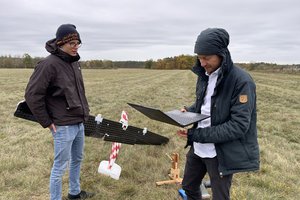Draft - Steps to Gravitational Engineering Degrees 3 Apr 2019
In essence, an acceleration field is an acceleration field, The only distinction for gravity, is when you trace the source of the acceleration ultimately back to the gravitational potential of known bodies, and changes in the acceleration field to changes in the gravitational potential. Since GW170817 showed that gravity and electromagnetism propagate at identically the same speed, and likely share the same underlying potential, I have been working out the consequences in terms of new technologies.
Because the natural signals are so weak, I have to work at micro, nano and femto accuracy most days, and some of the tougher problems require even more. I have been trying to use existing low resolution sensors by fitting the analog ones to high samplng rate ADCs then using the data to calibrate the instrument. Once calibrated, you need an array, to eliminate some of the local variations, and very long time frames. I use the sun and moon as reference points often. I am trying to adapt the seismometer networks to use them as gravimeters, but they all need to be upgraded, something that can be done in some cases by upgrades their amplifiers ADCs and data handling.
There is nothing wrong with analog sensors - if you control the amplifier, ADCs, calibration and modelling.
The gravitational potential changes associated with an earthquake, or even with ocean waves breaking on the beach used to out of reach as sources. But now there are increasingly 3D video techniques to essentially measure the 3D distribution of mass over time. Many people can do that now, some if they just tried. If you randomly sample from the points included, you can get a stable estimate of the gravitational potential over time at the detector locations. Two or more sensors, based on their location, can then sample at precise times to focus on any given location.
When I first tried to look for analog gravimeters to adapt to 3D imaging arrays, there were not many choices. But now there are so many, it is hard to keep up.
A fundamental mistake, from my point of view, is that people are so desperate to make products they accept convenient amplifiers and ADCs and lock into today's technology. They need to optimize the analog sensor portion, and be ready to bolt that into the best amplifier chains, algorithms and data gathering methods of the day. With the rapidly changing offerings, if you lock in today, you can missing a couple of orders of magnitude a few months from now..
The biggest gains, at least for earth-bases imaging, are from large networks of widely disbursed low cost, long operating, tightly connected sensors. For future generations, the best investment is not single big pyramids, but accessible labs and workplaces.
I think a lot about the impact of adding a new industry. Yes, it will complement and somewhat modify the current industries. Much of it is completely new. But a billion people trained in gravitational engineering - either as builders, or corporate enterprises, or as knowledgeable users - have to come from somewhere. The reason I chose to find low cost methods that are compatible with current average training world-wide, is it seemed to be better in the long run.
The sequence seems to be natural signals, and a few man-made ones, first. Adaptation of signaling might immediately show a deeper connection that can allow us to simply make a few modifications to sofware and work with acceleration fields as casually as we use lathes, 3D printers, linear accelerators, and chemical plants. So that is why I refer to "engineering", rather than theory.
Virtuall all the levitation methods can be expressed as acceleration fields. What they lack for larger weights and power levels are the precise monitoring and control systems. And that , in turn, requires several orders of magnitude in characterization and...
Read more » RichardCollins
RichardCollins

 hornig
hornig

 andrew.david.thaler
andrew.david.thaler